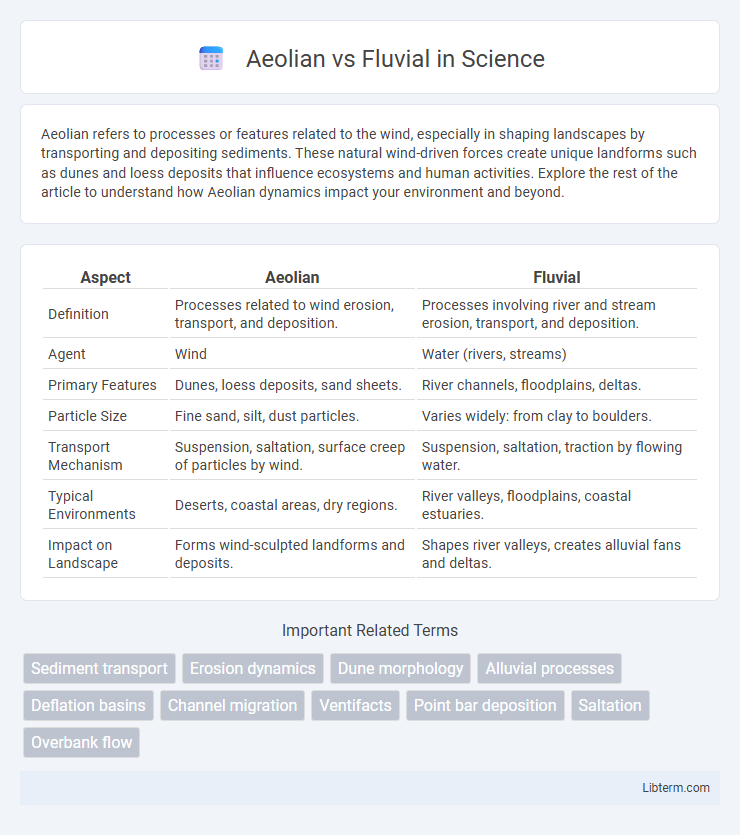Aeolian refers to processes or features related to the wind, especially in shaping landscapes by transporting and depositing sediments. These natural wind-driven forces create unique landforms such as dunes and loess deposits that influence ecosystems and human activities. Explore the rest of the article to understand how Aeolian dynamics impact your environment and beyond.
Table of Comparison
| Aspect | Aeolian | Fluvial |
|---|---|---|
| Definition | Processes related to wind erosion, transport, and deposition. | Processes involving river and stream erosion, transport, and deposition. |
| Agent | Wind | Water (rivers, streams) |
| Primary Features | Dunes, loess deposits, sand sheets. | River channels, floodplains, deltas. |
| Particle Size | Fine sand, silt, dust particles. | Varies widely: from clay to boulders. |
| Transport Mechanism | Suspension, saltation, surface creep of particles by wind. | Suspension, saltation, traction by flowing water. |
| Typical Environments | Deserts, coastal areas, dry regions. | River valleys, floodplains, coastal estuaries. |
| Impact on Landscape | Forms wind-sculpted landforms and deposits. | Shapes river valleys, creates alluvial fans and deltas. |
Introduction to Aeolian and Fluvial Processes
Aeolian processes involve the transport and deposition of sediments by wind, shaping features such as dunes and loess deposits. Fluvial processes refer to the movement of water through rivers and streams, which erode, transport, and deposit sediments to form landforms like valleys and floodplains. Both processes play crucial roles in landscape evolution and sediment distribution in arid and humid environments, respectively.
Defining Aeolian Processes
Aeolian processes involve the transportation and deposition of sediments by wind, predominantly shaping arid and semi-arid landscapes such as deserts. These processes include deflation, where fine particles are lifted and removed, and abrasion, where wind-driven particles erode surfaces, creating features like dunes and loess deposits. In contrast, fluvial processes are driven by running water in rivers and streams, responsible for sediment erosion, transport, and deposition in more humid environments.
Understanding Fluvial Processes
Fluvial processes refer to the actions of rivers and streams that shape the landscape through erosion, transportation, and deposition of sediment. These processes create landforms such as valleys, floodplains, and deltas by moving water and sediment downstream, influenced by gravity and channel morphology. Understanding fluvial dynamics is crucial for managing water resources, predicting flood patterns, and mitigating erosion in riverine environments.
Key Differences Between Aeolian and Fluvial Dynamics
Aeolian dynamics primarily involve the erosion, transport, and deposition of sediments by wind, shaping arid and semi-arid landscapes with features like dunes and loess deposits. Fluvial dynamics are dominated by the movement of water within river systems, influencing sediment transport, channel formation, and floodplain development. Key differences include the dominant transporting agent--wind for aeolian and water for fluvial processes--resulting in distinct sediment size sorting, erosion patterns, and landform characteristics.
Common Landforms Created by Aeolian Activity
Aeolian activity commonly creates landforms such as sand dunes, loess deposits, and yardangs through the processes of wind erosion, transportation, and deposition. Sand dunes exhibit various shapes like crescentic, linear, and star dunes, formed by wind patterns and sediment supply in arid environments. Yardangs are streamlined ridges sculpted by wind abrasion, illustrating the significant geomorphic impact of aeolian processes on desert landscapes.
Major Landforms Resulting from Fluvial Action
Major landforms resulting from fluvial action include river valleys, floodplains, deltas, and alluvial fans. River valleys are typically V-shaped due to continuous erosion by river flow, while floodplains are flat, fertile areas formed by sediment deposition during floods. Deltas form at river mouths where sediment accumulates, creating a network of distributary channels, and alluvial fans develop when rivers slow down upon exiting mountainous terrains, depositing coarse sediments in fan-shaped patterns.
Factors Influencing Aeolian and Fluvial Processes
Aeolian processes are primarily influenced by factors such as wind speed, sediment grain size, and vegetation cover, which affect the erosion, transport, and deposition of particles in arid and semi-arid environments. Fluvial processes depend on variables including water discharge, channel slope, sediment load, and basin geology, determining river velocity, sediment transport capacity, and channel morphology. Both processes interact with climate conditions and land use changes, shaping distinctive landscapes through erosion and sediment deposition patterns.
Environmental Impact of Aeolian vs Fluvial Erosion
Aeolian erosion, driven by wind, primarily affects arid and semi-arid environments, leading to the loss of topsoil and increased desertification, which can reduce land productivity and biodiversity. Fluvial erosion, caused by water movement, reshapes riverbanks and floodplains, often resulting in habitat alteration, sediment transport, and nutrient redistribution that impact aquatic ecosystems and water quality. Both erosion types contribute to landscape changes but differ in their spatial extent, sediment transport mechanisms, and ecological consequences.
Human Activities Affecting Aeolian and Fluvial Systems
Human activities such as deforestation, agriculture, and urbanization significantly impact both aeolian and fluvial systems by altering natural sediment transport and deposition patterns. Land clearance increases soil exposure to wind erosion in aeolian environments, while modifications like dam construction and river channelization disrupt sediment flow and water distribution in fluvial systems. These changes lead to heightened erosion, reduced water quality, and habitat degradation, affecting ecosystem stability in both settings.
Conclusion: Aeolian vs Fluvial—Significance in Landscape Evolution
Aeolian processes shape landscapes primarily through wind-driven erosion, transport, and deposition, creating features like dunes and loess deposits that dominate arid and semi-arid regions. Fluvial processes involve the movement of water in rivers and streams, sculpting valleys, floodplains, and deltas critical to sediment redistribution in diverse climatic zones. Both processes are essential in landscape evolution, with aeolian dynamics prevailing in dry environments and fluvial actions dominating wetter climates, collectively driving Earth's surface reshaping.
Aeolian Infographic

 libterm.com
libterm.com